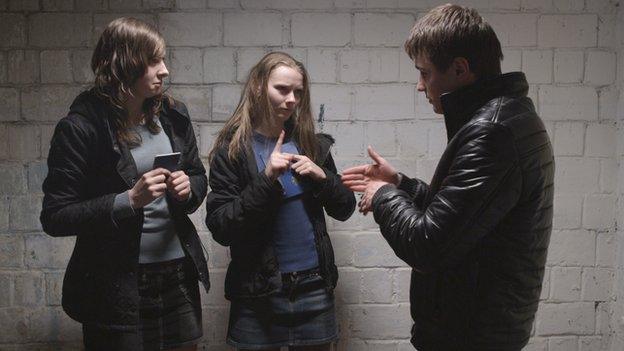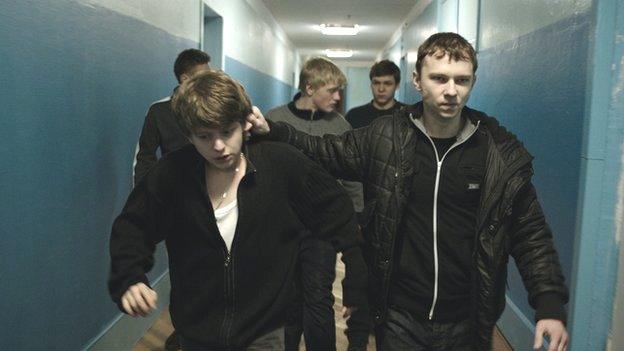Has The Tribe changed what a deaf film can be?
- Published
The Tribe encourages audiences to focus on physical movement
A film opening in the UK this week changes perceptions of what a deaf film can be, writes Charlie Swinbourne.
The Tribe is a Ukrainian film, directed by Myroslav Slaboshpytskiy, set in a deaf boarding school where everyone communicates in sign language. When a teenager joins the school, he wins acceptance into a network dealing in crime and prostitution. But when he breaks the unwritten rules of the tribe, his future is threatened.
The film is very naturally and subtly acted, with few cuts and lots of long uninterrupted takes where the camera stays still for minutes at a time. Watching The Tribe feels like peeking into an alternative reality, a troubling world where the deaf pupils have become a law unto themselves, marginalised so that they can be exploited.

Significantly, there are no subtitles and no voiceover. The audience is asked to understand the film by picking up on the actors' physical expressions as they sign to each other - almost like watching a silent film. Because sign languages vary in countries across the world, British deaf people are likely to understand as little as anyone else.
At first, this is deeply unsettling. Ten minutes into the film, I wasn't sure if I could carry on watching it. I'm a film-maker and scriptwriter, and words are important to me. As a deaf person, I also wanted to know exactly what they were signing to one another, and where the plot was going. Having spent hours painstakingly adding subtitles and voiceover to my own films and programmes, I couldn't help but wonder whether the decision to give no access to the dialogue was a cop-out.
Then I started to pick up on the characters' relationships, changes in mood, and began to understand what was going on. Cleverly, by removing subtitles the audience is forced to engage more with the deaf characters, to really look in order to understand. I can't deny that there's also something I quite like about hearing people being put into a position we deaf people often find ourselves in - having to figure out what is being said.
What's also different about the film, from a deaf perspective, is how extreme the story is, and the world it depicts. Most deaf programmes or films face restrictions because they are made to be shown before the watershed in daytime hours where signed TV shows tend to be aired. Consequently it's rare to see a film with deaf characters where adult themes are explored. In my view, the themes are not simply explored for effect in The Tribe - they are justified by the story that's being told.

Many deaf people I know have responded very positively to the film, including deaf film maker Ted Evans, external, who says: "It's incredibly unique and original and essentially shows us that [hearing] people can watch a film in sign language, even without subtitles or translation of the dialogue, so long as the film has a clear narrative and that the overall production of the film is at a high standard."
Not all deaf people are fans. Raymond Luczac, external, a US author and filmmaker, has written a detailed blog, external criticising the film, calling it "an exploitation film made by hearing filmmakers", accusing the director of depicting the deaf pupils as savages.
Not everyone is going to like The Tribe, and just as it's divided deaf audiences, it's sure to divide hearing audiences too. But for me, what's exciting is where it could take us in the future. Now that a film starring deaf actors, fully made in sign language has blazed a trail through festivals and has gone on mainstream release, a door has hopefully opened for other deaf film-makers to tell their stories on a bigger platform.
The Tribe will be in cinemas from 15 May.
Follow @BBCOuch, external on Twitter and on Facebook, external, and listen to our monthly talk show